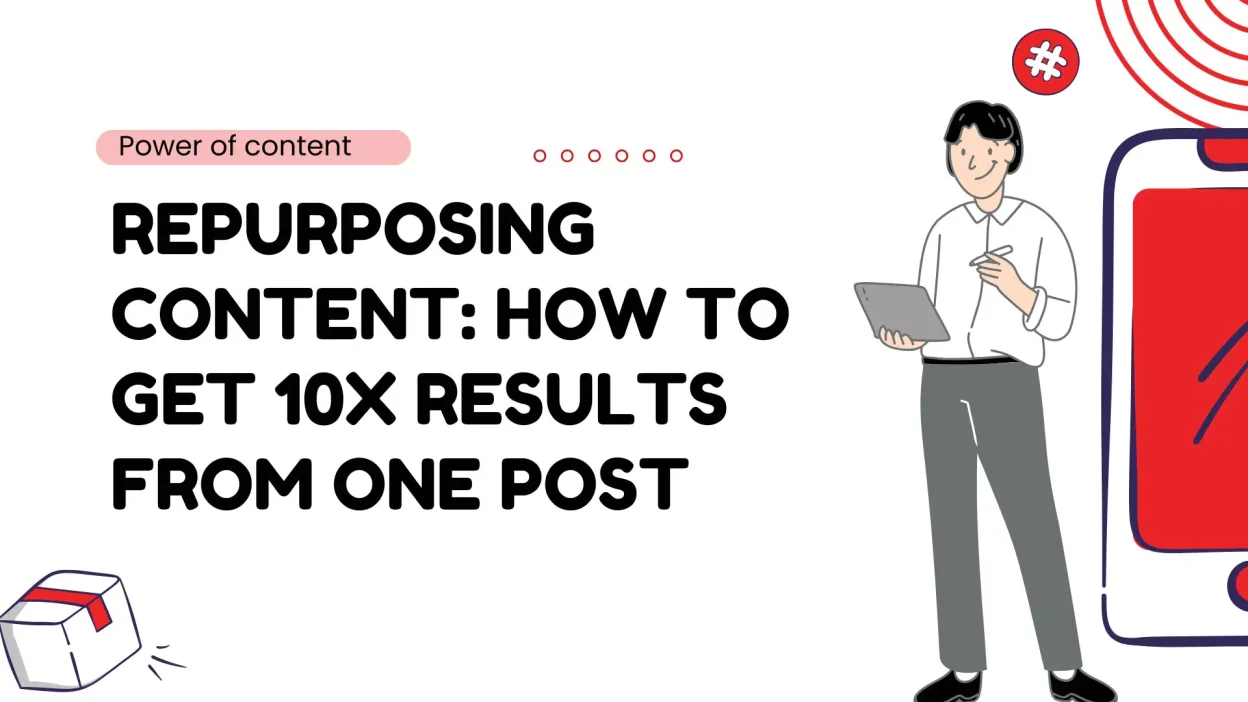Content creation itself is an investment in terms of time, effort, and resources. But what if you could take that one great piece of content and create 10 from it, multiplying its reach and power while saving time? That’s the magic of repurposing content.
In this blog, I will walk you through the art of repurposing, how you can repurpose content to get 10x results, from spotting content worthy of repurposing, to repurposing it to new formats. By the end of this article, you’ll have a plan to save resources, increase viewership, and create a longer lifespan for your content.
What Is Repurposing Content?
Reusing content is the art of modifying or repurposing your existing piece of content, transforming it into another piece for a different purpose. The idea is to get the most bang for your buck while reaching different types of people across different outlets.
For instance, an article you’ve researched can be parsed down into an infographic, YouTube video, a series of social media posts, or something to put into an eBook. This method guarantees that oracles end up engaging with the masses, in whatever message form they desire.
It’s not just a time saver, but also an amplification in your content’s ROI as your content will, now, live longer and become more discoverable.
What Are the Benefits of Repurposing Content
Why should any marketer or content creator start repurposing? Here’s what you’ll gain:
-
Reach wider: You can use repurposing to reach users across other channels, such as social media, email, video platforms, and podcasts.
-
Improve SEO performance: When you publish content that relates to one another on platforms then also backlinking is happening and generating good amount of traffic for the website.
-
Support your message: Echoing messages in a supportive role help readers retain and pay attention to the has a positive effect on your credibility.
-
Save time and effort: Concentrate on converting current high-performing content into new formats instead of constantly creating from scratch.
So now that we know it’s worth a fairly large chunk of time, how do you make one piece of content 10 times more effective?
Step 1: Find Content With The Most Potential
Repurposing begins with selecting the right piece of content.
Assess Your Best Performers
Start by evaluating how visitors, blog posts, and social posts perform on your website. Find the posts that are popular in terms of engagement, traffic or shares. The content that performs well already has intrinsic value; the best content is content that can be repurposed.
Example: Once a blog post is timeless (like “5 Tips for Remote Team Management”) it can be rewritten in a multitude of ways, because the historical context is irrelevant.
Consider Evergreen Topics
Evergreen subjects remain relevant for years ahead and often got better when repurposed. While fads are fast, trends are short-lived.
Audience Feedback
What are people asking over and over again? If a certain subject keeps cropping up in comments, emails, or FAQs, you may want to create new content out of it.
Pro Tip: Focus on what content resonates best with your core business objectives rather than its popularity.
Step 2: Rethink What a Format Is
A few of the biggest secrets to repurposing successfully are to take your existing ideas and put them into different formats so that they fit onto other platforms or are better suited to a certain audience.
Chunk Out Long-Form Content
Begin with a long blog post, whitepaper, or case study. You can get more than one post out of one piece.
-
Share insightful questions with your network on Twitter or LinkedIn.
-
Feature stats or steps in an Instagram carousel post.
-
Compile smaller standalone blogs or FAQs from subtopics.
Example: A listicle-style blog on “10 Tips for Better Email Marketing” could translate to 10 individual email tips posted to social media on a daily basis.
Turn Blog Posts into Videos
-
Repurpose blogs into tutorials, explainer videos or Q&A sessions.
-
Create short, punchy videos with tools like Canva or Animoto.
-
Post to the likes of YouTube, TikTok, or Instagram Reels.
Use Data for Infographics
People absolutely adore visual stuff. Extract key facts, stats, or takeaways from your content and create an infographic for quick sharing on Pinterest and other forums.
Repurpose Content into Podcasts or Webinars
-
Deep-dive blog topics on a podcast; go into depth on certain things.
-
Host a webinar to teach concepts in your content to your audience. Record it and package it as on-demand content.
Create Downloadable Resources
If you publish in-depth content, repurpose that content as PDFs, cheat sheets, templates, or eBooks. These forms are also excellent lead magnets.
Examples, Formats Checklist:
-
Blog ➡ Social Media Snippets
-
Blog ➡ YouTube Explainer Video
-
Article ➡ Email Series
-
Interview ➡ Podcast Episodes
The options are vast, but the point is to get your ideas into the audience’s favorite way of consuming them.
Step 3: Tune for Each Platform
Repurposing “is not just the simple act of copying, but adapting content to fit the needs and tone of different platforms,” she says.
Know Your Platform
Various channels for different people and tastes. Plan your mission accordingly.
- LinkedIn: Work-related musings, insights into professional life, and success stories.
- Instagram and TikTok: Short, visually appealing posts or videos. Keep text concise.
- Twitter/X /X: Post hooks, quotes, and thread formats to create conversation.
Use SEO Strategically
Your search engine ranking can be improved by concentrating on building your website on keywords. With blogs or other content types, updated meta descriptions, cross-linked to other content and optimized images for SEO.
Craft Headlines for Impact
Platforms like social media are way too hook-dependent. Borrow ideas from your blog headline, but modify it to stand out.
Example:
- Blog post head: “10 Steps Toward a More Productive You”
- Instagram post hook: “Feeling in a funk at work? These three productivity hacks are going to revolutionize your life.”
Pro Tip: You should never just recycle content verbatim without adjusting for the tone, demographic, and platform it is on.
Use Community Activation
Emphasize repurposed content with audience interaction.
- Post polls for feedback to drive future repurposed material.
- Prompt comments, UGC, or challenges on the theme of your content.
- Create a discussion through platforms like Facebook or LinkedIn groups.
When you frame repurposed content as tools for engagement, you’re not only extending the life span of the content, you’re increasing its reach in the community.
Step 5: Plan and Document a Workflow
REGULATION
Yes
No
Your local regulations apply to your assembly area, including how and where products may be handled and stored.
Click here to enter text.
Knowing how to repurpose content is one thing, but writing a workflow ensures the practice is repeatable.
- Begin with a content audit to find assets that are ripe for repurposing.
- Create a repurpose roadmap for each item – that is, where will that piece appear, in which format and on what platform?
- Track progress with project management tools like Trello or Asana.
Reusing workflows saves teams time, ensures project alignment, and mitigates duplicate content work.
So don’t hesitate … Seize these Shopping Carts TODAY!
The long and arduous process of content repurposing may seem overwhelming at first, but buckle up because once you get the hang of it, you will never see content creation the same way ever again. We can not continue to dump billions of dollars ‘ worth of goods into a landfill. In desperate times, we take desperate measures, and although chances are you won’t want to carry around a suit made out of 7-Up bottles all day, this is the thinking that needs to happen. Addicted to Coke? Who isn’t? With today’s recycling, we can make a “green” decision to re-bottle the 7-Up glass into your latest designer outfit. Instead of making a 600-ton environmental mistake for a single-use creation, it makes far more sense to recycle, re-use, and use your intellect!
Just remember… It’s not about the QUANTITY of content that you put out there. It’s a matter of getting more out of what you’ve already written.

